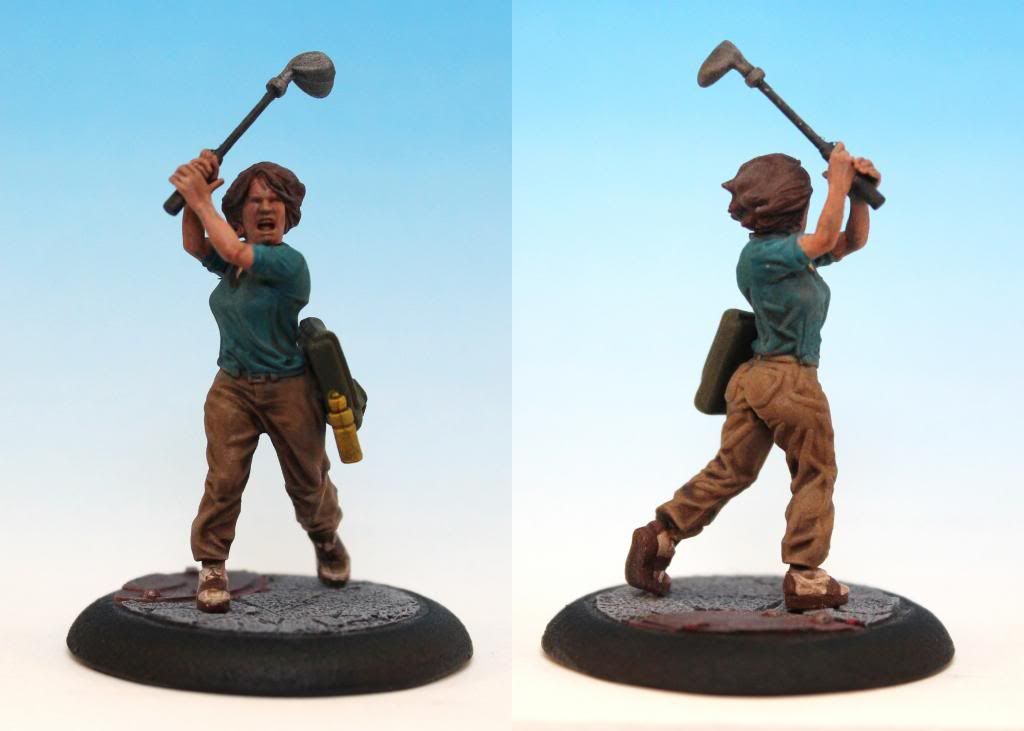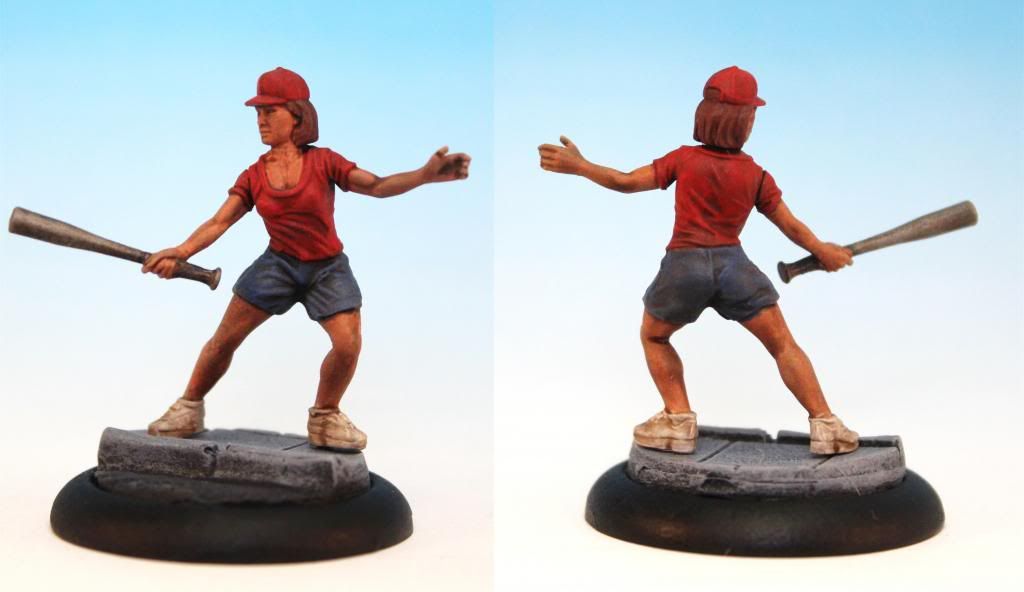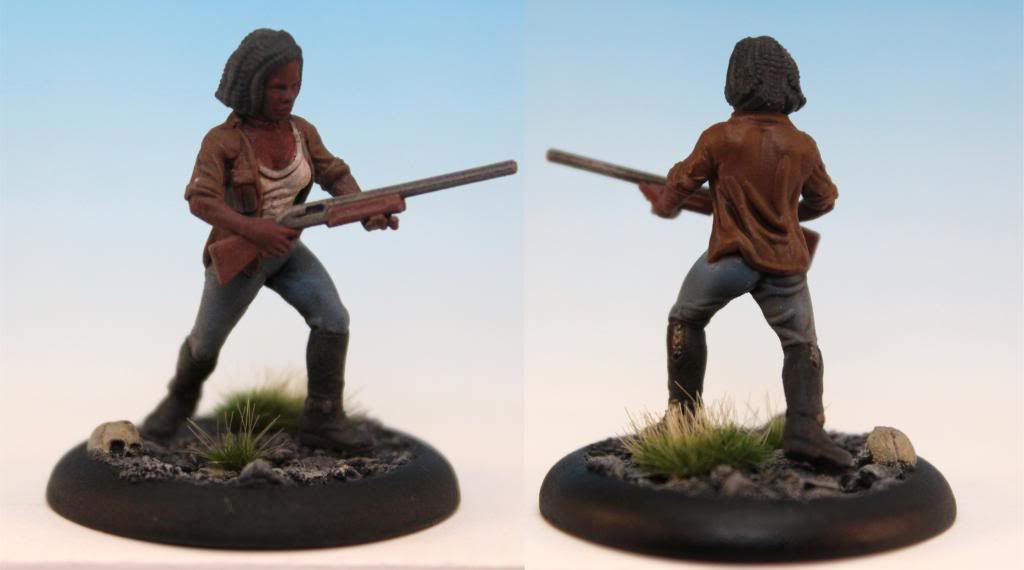I’ve just finished painting my first batch of female
survivors from the new Wargames Factory kit and I thought I would do up a
review similar to the male set as the boxes have quite a bit of similarity and
a certain amount of crossover possibilities.
The female survivor kit is very
similar to the male set. In fact they are near mirror images of one anther in many aspects, so I won't go into quite as much detail. Here is a link to my review of the male set: The Males
I’ll hopefully follow shortly with a separate post showing some scale shots with survivor miniatures from other ranges.
The kit “Apocalyptic Survivors: The Women”
follows the release earlier this spring of the male set and represents
female civilians in modern dress ranging from lightly armed with melee weapons
up to heavily armed with assault rifles and even an RPG.
 |
| Box photo courtesy of Wargames Factory |
Even more so than the men, plastic female civilians have
been tough to come by and for me this kit is a welcome addition to my
collection of ATZ figures. Also, if you
are a fan of the Zombicide games and missed out on some of the promotional
figures, you could put together some reasonable proxies from this kit as
well.
FRAME 1 – BODIES AND
BASES
Each kit comes with three frames containing ten sets of
bodies, bases and arms. There are also
fifteen sets of heads as well as a couple of pouches and even a spare set of
high heels.
 |
| Sprue Photo Courtesy of WGF |
The casting is generally good, however I did notice that on
some of the bodies there is a distinct mold offset line that will need to be
taken care of. It’s not serious enough
that you’ll lose detail, but given the large amounts of cloth and flesh, I did need longer to clean the figures up
than on the male set. Be wary, there
are numerous small parts such as the arrow, golf club, compound bow and finger tips that will need to
be handled very carefully during cleanup lest they bend or break. Also, I had a casting defect on the golf club
shaft. This would have been a delicate
part regardless, but the way the plastic flowed through the mold, it met in the
middle of the shaft and didn’t bond. The
part fell apart for me just cutting it from the frame. I solved the problem by replacing the entire
shaft with a straight pin which might have had to be done just for strength anyway.
 |
| Sprue Photo Courtesy of WGF |
As with all recent kits the top and bottoms of the frame
come with a set of pegs and holes so you can stack them with space in
between. This is nice as it prevents
delicate parts from rubbing and potential breaking as you slide the frames in
and out of the box. Also, the frames
match the dimensions of the male set so they can be stacked together. The bases are the same 25mm, round bases with straight sides and the WGF logo on the bottom. They are perfectly serviceable but I chose to go with 30mm round lip bases to match my other survivors.
There are no instructions, but the body and arm combinations
are labeled. Unlike the male set which
had letters and numbers, the female parts are only labeled by letters. That means for body “A” all of the arms are
also lettered simply “A” as well. There
are at least four arms for most sets between the body sprue and the weapon
sprue, so you will need to be careful and dry fit parts to make sure you still
have the right combinations of left and right arms.
FRAME2 – SPARE WEAPONS AND ARMS
There is a single weapons frame included that has a
wonderful set of alternate arms for most of the figures as well as a large
assortment of extra weapons and equipment.
There is still a distressing proportion of assault weapons to standard
fire arms and a notable lack of enough improvised melee weapons, but there is
enough variation that it is worthwhile.
Unfortunately, like the male set the artist had the same tendency to
copy and paste the weapons designs. As
an example, there are five spare pistols on the frame, they are all copies of
the colt 1911. No revolvers or other
types of semi-automatics included.
ASSEMBLY
Once the clean up of the parts was complete, the figures
went together well from the neck down. Once you get to the head, things got came to be a
bit of a challenge. I found that
few of the neck joints lined up very well with the heads. That coupled with the fact that
many of the heads had hair below the collar line meant that you need to dry fit
the heads before any gluing. I would estimate that I had to either trim the collar or the hair on at least half of the
heads. Even then, I couldn’t get the
joints to look quite right and there were gaps that needed filling.
You will also end up with gaps on the bare armed figures at
the shoulder as well, so I had to come back and use green stuff on many of the
shoulders and all of the neck joints.
Unfortunately the spaces are smaller than my sculpting tool and the shapes awkward so many of my
neck joints look a little wonky even after filling.
With the male set I just dove into construction right away
without any planning. I ended up using
a lot of the arms from the spare weapons sprue.
This ended up being a mistake as there is usually one or two copies of
the arms on the weapons sprue versus three copies from the body sprue. With my first set of male figures I ended up coming up with combinations I
wanted to retry but didn’t have the arms.
For the females I played it safe and I started out my first batch of ten figures using just
the arms off of the body sprue, so I can better plan out how to use the rarer arms
from the weapons sprue on future figures.
ASSEMBLED FIGURES
Here are the first ten figures I’ve put together with some
thoughts on each body:
 |
| FOUR! |
First up is an angry gal wearing slacks and a sweater vest, in a
swinging pose. The intended set of arms
has a golf club and it’s a good sculpt of her teeing off. As I mentioned above, the shaft of the club
is abysmally thin and I ended up replacing it with a straight pin. Unfortunately I didn’t measure well enough
and the shaft is maybe one millimeter short, but at least I got it
straight. If you don’t like the golf
club, there is also a truncheon or baseball bat you could use. Just like the male figure swinging the
cricket bat, there isn’t another good set of arms for this gal, so I don’t
really see making all three of these bodies.
Unlike the males, I added a satchel with a water bottle to the
figure. Unfortunately, without a strap,
it looks a little big and silly on her.
If I use the big satchel again I think I’ll add a green stuff strap.
The next figure is one of my favorite bodies in the kit. She’s got cargo pants, combat boots and a
loose jacket. She’s got a nice neutral
stance so almost all of the arms with sleeves will fit her. For the first figure I used the M-16 and gave
her a satchel of pipe bombs a canteen and a combat knife. This gal looks like she’s ready to face the
apocalypse.
This is the “kid” figure for the kit and represents a little
girl in a frilly dress. I would have
preferred a more casual dress like the boy from the other set, but this is well
sculpted for what it is. The head in the
Kevlar helmet is a nice touch, but it would have worked better if it was more
obviously over sized. This one looks like
it fits too well. The scoped revolver is
a nice weapon and I will probably use the other copies as weapon swaps on other
figures. Also, I’ve dry fit the head on
other bodies and it should work to make an adult as well.
This figure is another sports fan wearing shorts and a
t-shirt. This is the one figure where I
cheated and used a part from anther kit.
The intended weapon was a tennis raquet. I really didn’t like the look so I nipped a baseball bat I had left over from the male kit. I gave her a head with a ball cap so she must
have been at softball practice when the apocalypse came. I’m not a big fan of the pose of the left
arm as it makes it look like she’s fencing instead of whacking zombies
though. On the plus side, the figure is
versatile enough to take most of the sleeved arms from the kit.
Now we get to the controversial bit. This figure is obviously overweight and she
looks a bit sloppy to boot with sagging shorts and visible butt crack. I’m kind of late to this review, so I’ve seen
a number of reactions to this figure ranging from some wishing for more figures
that reflect “real world” people to one being truly offended by it (link),
stating that it was an attack on overweight people.
I suppose there was no “right” answer for
this but WGF making nine “fit” figures and one token overweight one certainly
highlighted the difference. Interestingly I didn't read any such reaction pro or con from the overweight male figure. From a
practical matter though I don’t like it because there is really only one set of
arms in the kit that fit the figure. The
large attachment point at the shoulder and wide shoulders mean that the RPG is
the only set of arms that fit and I really don’t need three of these. As a consolation though, the arms for the fat
male figure fit well so I can give her an AK-47 (or pistol & machete) and give one of the RPGs to the
one of the overweight male bodies. At
least she’s not wearing a muumuu.
Another issue for me is that while there are spare RPG’s on the
weapon frame, there are no spare warheads or the carrying satchel, so this gal
is now carrying a one shot weapon. If I
were less lazy I’d try to throw one together with some green stuff, but life is
too full right now as it is, so I just let it go. Also, in hindsight I should have given her a holstered weapon or a rifle slung over her shoulder, but that would have taken more effort and greenstuff than I had time for.
Another reaction I’ve found interesting is that a number of
people have scoffed at the way the sculptor has chosen to show the figure
holding the RPG. Assuming the model is an RPG
7, this is indeed the wrong way to hold it, but the idea that anyone who has
not used one before would intuitively know the correct way is overestimating
the ergonomics of the weapon and underestimating the ability of people to get
things wrong. During a tour in Iraq with
the US army I had the chance to both fire an RPG and train some Iraqi recruits
in firing them. During that mission I saw people
holding and RPG just about every wrong way you can imagine, so the idea that a
civilian with no experience could pick up and hold an RPG wrong is perfectly
believable to me.
Here’s a figure in a suit coat and short skirt. She’s at least sporting a two handed grip on
a pistol and might actually be able to hit something.
I gave her a head with sunglasses and painted her up in black. I’ll team her up with the suit figure from
the male set and they can be Mulder and Scully FBI types. This body is also a little tough as the neck
joint is a little wonky and as you can see that I’ve goofed up the joint a bit. On the plus side this is another versatile
figure that can take a number of different sleeved arm combinations.
This figure is an interesting juxtaposition. You’ve got a girl in bustier and miniskirt
sporting a fancy schmancy compound bow with all the bells and whistles. She’s also bare foot, which is no way to face
the end of the world as I imagine there will be plenty of broken glass. Unfortunately, the bear shoulders and the stance
don’t leave much in the way of other good arm options for her.
Here is another bear shouldered figure this time sporting
double pistols. I know that WGF needs to
sculpt a certain amount cinematic flare to their figures, but I’m always bothered
by the pose. On top of that, she’s
running too. In fact this pose is the surest
way to not hit anything more than five feet away. The only other arm choice is a chain saw,
which with the running pose is even sillier. I tried out some of the smaller pouches on her and they work, but are a little too over sized to really work in my opinion.
 |
| Git along zombies! |
Here’s another dual gun toting chic, this time it is a
cowgirl type. Yeeha! She’s sporting a pair of
Uzis, so she might have a better chance of hitting something than the last
figure. Another figure with bare arms, so
swap options are limited. I went with the smaller pouches on her back which looks more natural than the large satchel on the golfer.
Last up is another figure with lots of options. The intended set is a semi-automatic shotgun, but again the neutral set of the shoulders means that most of the other sleeved arms will fit. This is also another figure where the neck shape and high collar interfere with most of the heads, so the joint is a little off of what it should be.
CONCLUSION
As I said above, this set is almost a mirror image of the male set with mostly the genders changed up, so If you liked the male set, you'll most likely enjoy this set as well. However, most of the flaws from the male set show up here as well including mono-pose bodies, limited options as to arms and weapons and too many copies of the same weapons on the accessory sprue.
That being said, the price is still right. Assuming that you pay full retail price and only build ten of the figures, you are still only paying two dollars a figure and getting a ton of useful extras for other conversions.
Me, I like the set and think they'll make excellent additions to may growing hoard of survivors.






























